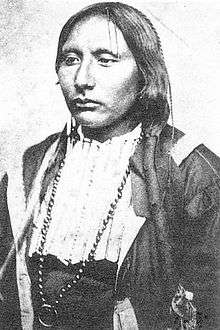Big Tree (war chief)

Big Tree (Kiowa: Ado-ete (unknown c. 1847–1927),[1] was a war chief of the Kiowa. He was a loyal follower of the fighting chiefs party (Satank, Satanta, Guipago), and conducted frequent raids upon other tribes and white settlers, often being associated with Tsen-tainte ("White Horse").
On June 21-22, 1870, Big Tree led a raiding party on an attack on Fort Sill in Indian Territory, but the raid wasn't as successful as the previous one led by White Horse.
On 9 July 1871, a group of Kiowa soldiers, led by chief Satanta, Setangya and Big Tree stole 41 mules after killing seven men in a rain in Texas.[2] Big Tree was buried in a makeshift grave underneath one of his favourite trees in the high country.
The Warren wagon train and trial
On May 18, 1871, the Warren wagon train, travelling down the Jacksboro-Belknap road heading towards Salt Creek Crossing, met a large group of riders ahead. Hidden in a thicket of scrub in the Salt Creek Prairie, the Kiowa had observed, without attacking, the transit of General William Tecumseh Sherman's inspection retinue. The previous night, Mamanti ("He Walking-above"), the powerful shaman rival of Tene-angopte ("Kicking Bird" or "Striking Eagle")'s friend Napawat ("No Mocassins"), had prophesied that this small party would be followed by a larger one with more plunder for the taking, and the warriors let the soldiers go. Only three hours later the ten mule-drawn wagons filled with army corn and fodder fell into the ambush, and the warriors destroyed the corn supplies, killing and mutilating seven of the wagoneer's bodies. The Kiowa warriors lost three of their own but left with forty mules heavily laden with supplies. Five white men managed to escape, one of whom, Thomas Brazeale, walked to Fort Richardson, some twenty miles away. Col. Ranald S. Mackenzie, as soon as he learned of the incident, informed Sherman. Unlike some others (such as Tsen-tainte "White Horse", Zepko-ete "Big Bow" and Mamanti), Ado-ete ("Big Tree") was identified as one of the leaders, along with Satanta and Satank; notwithstanding the intervention of Guipago, with loaded rifles and guns and well prepared to fight, they were arrested and jailed at Fort Sill. Along the way to Jacksboro, Texas, while travelling to Fort Richardson for trial, Satank attempted to escape and was killed. Satanta was found guilty of murder and sentenced to death, as was Big Tree; but Edmund Davis, the Governor of Texas, under enormous pressure from leaders of the so-called Quaker Peace Policy, decided to overrule the court, and the punishment for both was commuted to life imprisonment. Satanta and Big Tree were convicted of murder on 5-6 July in Jack County, Texas. Thanks to the stubborn behaviour of Guipago, who forced the U.S. Government to agree by seriously threatening a new bloody war, Satanta and Big Tree were freed after two years of imprisonment at the Huntsville State Penitentiary in Texas.
Big Tree didn't join the Kiowa party, led by Guipago and Satanta, going with the Comanche chief Quanah and several others to whip out the hidemen at Adobe Walls, nor did he take part in the Buffalo and Red River war so, when Chief Kicking Bird was forced by General Philip Sheridan to choose those among his tribe to be imprisoned in the east, Big Tree wasn't among them. In 1878, he and the other Kiowa were returned to the reservation in Indian Territory near Fort Sill, where he had still a career as a chief until he died on November 27, 1929.
See also
Notes
- ↑ Encyclopedia of Indians of the Americas. St. Clair Shores, Mich.,: Scholarly Press. 1974. p. 147. ISBN 0403017955. OCLC 858894.
- ↑ Indians of Nebraska : past and present. St. Clair Shores, Mich.: Somerset Publishers. 1999. p. 104. ISBN 0403099293. OCLC 41585914.